Antiplatelet Market Research, 2032
The global antiplatelet market was valued at $3.8 billion in 2022, and is projected to reach $5.8 billion by 2032, growing at a CAGR of 4.2% from 2023 to 2032. Antiplatelet drugs are the medications used to prevent or reduce the risk of blood clot formation by interfering with the activation or aggregation of platelets. These drugs work through various mechanisms. For example, ADP receptor inhibitors, such as clopidogrel and ticagrelor, block the adenosine diphosphate (ADP) receptors on platelets, preventing platelet activation and aggregation. Other medications Clopidogrel and Ticagrelor target specific receptors on platelets to prevent their activation and subsequent clot formation. These antiplatlet drugs reduce the risk of clot-related complications by keeping platelets from sticking together and forming clots.
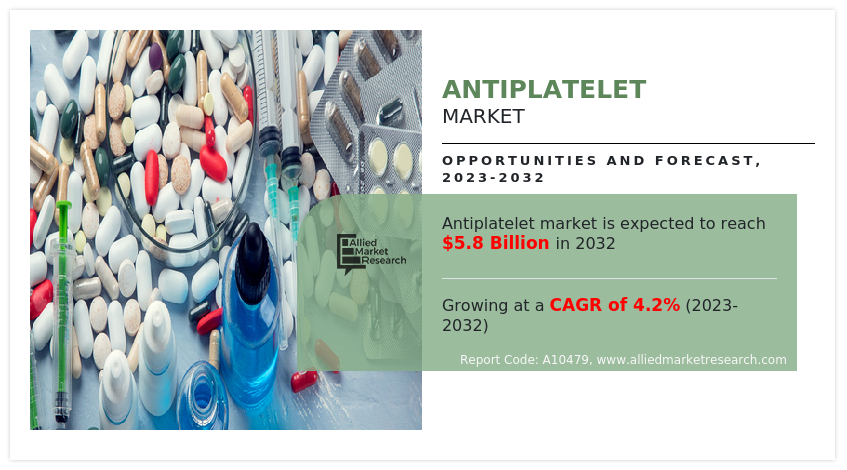
Market Dynamics
Increase in the prevalence of cardiovascular diseases such as heart attack and stroke is the major key factor that drives the market growth. For instance, Centers for Disease Control and Prevention (CDC) estimated that 523 million people had some form of cardiovascular disease in 2020 across the globe. In addition, according to the same source, every year around 805,000 people in the U.S. had a heart attack. Thus, surge in prevalence of cardiovascular diseases drives the demand for antiplatelet drugs market to treat these conditions.
Antiplatelet medications lower the occurrence of cardiovascular events such as heart attacks and strokes. They have been proven to be effective at preventing platelet aggregation and reducing the formation of blood clots in clinical trials and research studies. The positive outcomes associated with these drugs drive their continued use and propels the market growth. Increased awareness about the risk factors and symptoms of cardiovascular diseases has led to improved diagnosis rates. Routine screenings and early detection of these conditions have become more prevalent, resulting in a higher demand for antiplatelet drugs as part of preventive measures and treatment plans.
The availability and accessibility of healthcare infrastructure also impact the demand for antiplatelet drugs. In addition, countries such as U.S. have well-developed healthcare systems including advanced hospitals, and pharmacies and better equipped to diagnose and manage cardiovascular diseases which support the market growth. Adequate access to healthcare services ensures that patients can receive appropriate prescriptions and follow-up care, driving the demand for antiplatelet drugs. Rise in geriatric population further contributes toward the market growth. Older adults are more susceptible to cardiovascular diseases and related complications, leading to a higher demand for antiplatelet drugs to prevent thrombotic events which is expected to contribute toward the antiplatelet industry growth.
The growth of the antiplatelet drugs market is expected to be driven by high growth potential in untapped, emerging markets due to availability of improved healthcare infrastructure, increase in unmet healthcare needs, and rise in prevalence of cardiovascular diseases.
Pharmaceutical companies are investing in research and development to develop new and improved antiplatelet drugs support the market growth. In addition, the introduction of more potent antiplatelet agents, such as P2Y12 receptor inhibitors like prasugrel and ticagrelor, has provided physicians with a wider range of treatment options. The continuous innovation and development of newer and more effective antiplatelet drugs contribute to the market's growth.
Furthermore, the healthcare industry in emerging economies is developing at a significant rate, owing to rise in demand for enhanced healthcare services, significant investments by government to improve healthcare infrastructure, and development of the medical industry in emerging countries which further support the market growth.
The demand for antiplatelet drugs is not only limited to developed countries but is also being witnessed in the developing countries, such as China, and India, which is expected to drive the market growth. Moreover, a rise in government initiatives for cardiovascular diseases such as stroke drives the antiplatelet drugs market growth. For instance, The Department of Health & Family Welfare, Government of India, provides technical and financial support to the States/UTs under the National Programme for Prevention and Control of Cancer, Diabetes, Cardiovascular Diseases and Stroke (NPCDCS). These initiatives often include awareness campaigns, screening programs, and subsidized access to medications.
Antiplatelet drugs carry a risk of adverse effects, including bleeding complications. These medications inhibit platelet function to prevent blood clotting, but this may also increase the risk of bleeding, especially in certain patient populations or when combined with other medications. The potential for bleeding complications and adverse effects can limit the use of antiplatelet drugs in some patients, leading to cautious prescribing and potentially reducing the market demand. Thus, side effects of the antiplatelet drugs hinder the market growth.
The COVID-19 pandemic had a moderately positive impact on the antiplatelet market. There has been significant research on the potential benefits of antiplatelet therapy in COVID-19 patients. Studies suggested that antiplatelet medications such as aspirin, may have anti-inflammatory and antithrombotic effects that reduce the complications associated with COVID-19. This had increased interest in the use of antiplatelet drugs as adjunctive therapy in COVID-19 management has driven the market for these medications.
Furthermore, the market recovered after the pandemic and showed stable growth for the antiplatelet market. This is attributed to the increase in adoption of antiplatelet drugs, rise in number of people suffering from the cardiovascular diseases, and rise in R&D activities.
Segmental Overview
The antiplatelet market is segmented into drug class, route of administration, distribution channel, and region. By drug class, the market is categorized into adenosine diphosphate (ADP) receptor inhibitors, irreversible inhibitors cyclooxygenase, and others. On the basis of route of administration, the market is bifurcated into oral and injectable. As per distribution channel, the market is classified into hospital pharmacies, drug stores & retail pharmacies, and online providers. Region wise, the market is analyzed across North America, Europe, Asia-Pacific, and LAMEA.
By Drug Class
The adenosine diphosphate (ADP) receptor inhibitors segment dominated the antiplatelet market size in 2022 and is expected to remain dominant throughout the forecast period, owing to well-established efficacy and safety profiles of ADP receptor inhibitors. In addition, potent antiplatelet effects make them a preferred choice for the prevention and treatment of cardiovascular diseases, driving the demand for ADP receptor inhibitors.
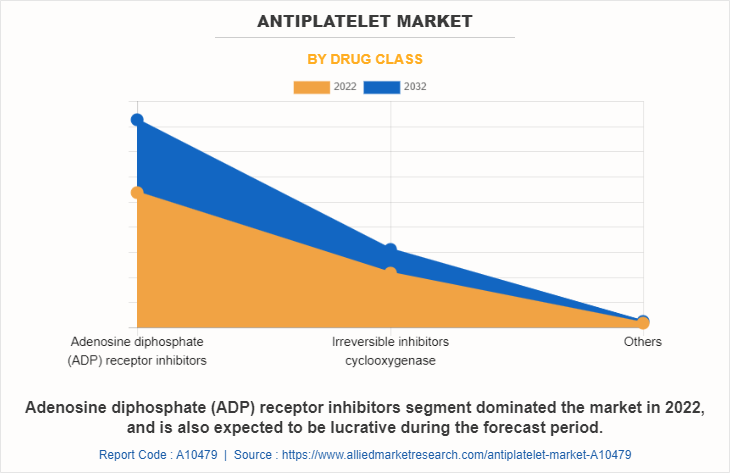
By Route of Administration
The oral segment dominated the antiplatelet market size in 2022 and is anticipated to continue this trend during the forecast period. This is attributed to rise in adoption of oral antiplatelet drugs to treat cardiovascular diseases. In addition, diverse options and availability of oral antiplatelet medications enable physicians to tailor treatment regimens based on patient characteristics, further driving the dominance of the oral segment.
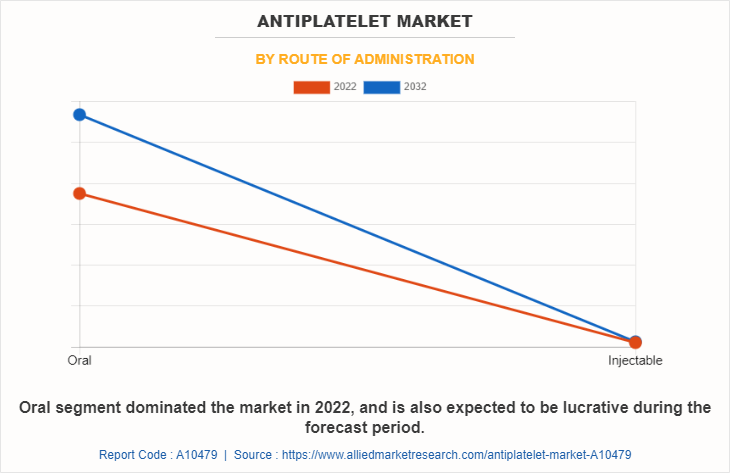
By Distribution Channel
By distribution channel, the market is classified into hospital pharmacies, drug stores & retail pharmacies, and online providers. The drug stores and retail pharmacies segment held the largest antiplatelet market share in 2022 and is expected to remain dominant throughout the forecast period, owing to easy accessibility and convenience, wide product range, reliable prescription fulfillment, patient consultation, and guidance services. These factors collectively contribute to the continued dominance of drug stores and retail pharmacies in the antiplatelet market.
However, online providers segment is expected to register the fastest growth during the forecast period, owing to convenience of online ordering, home delivery, and easy accessibility through digital platforms which has attracted a significant number of consumers. The increase in adoption of digital technology and e-commerce platforms is driving the rapid growth of the online providers segment in the antiplatelet market forecast.
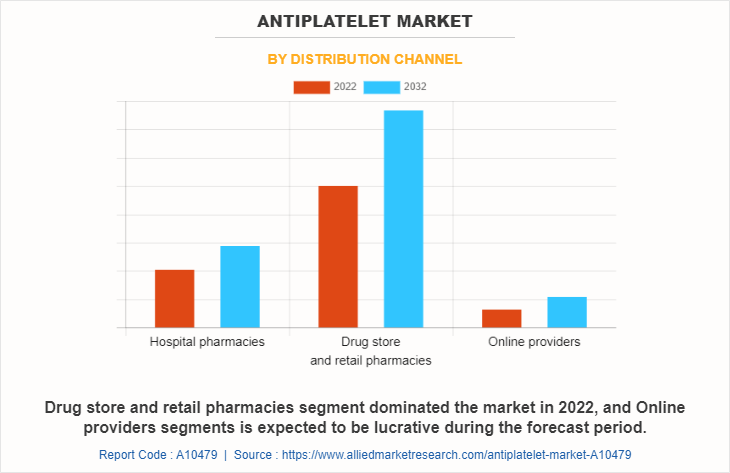
By Region
The antiplatelet market is analyzed across North America, Europe, Asia-Pacific, and LAMEA. North America accounted for a major antiplatelet market share in 2022 and is expected to maintain its dominance during the forecast period.
Presence of several major players, such as AstraZeneca plc, Bayer AG, Otsuka Pharmaceutical Co., Ltd., Sanofi S.A., and advancement in manufacturing technology for development of effective treatment options for cardiovascular diseases in the region drive the growth of the market. Furthermore, the presence of well-established healthcare infrastructure, high purchasing power, and rise in adoption rate of antiplatelet drugs are expected to drive the market growth.
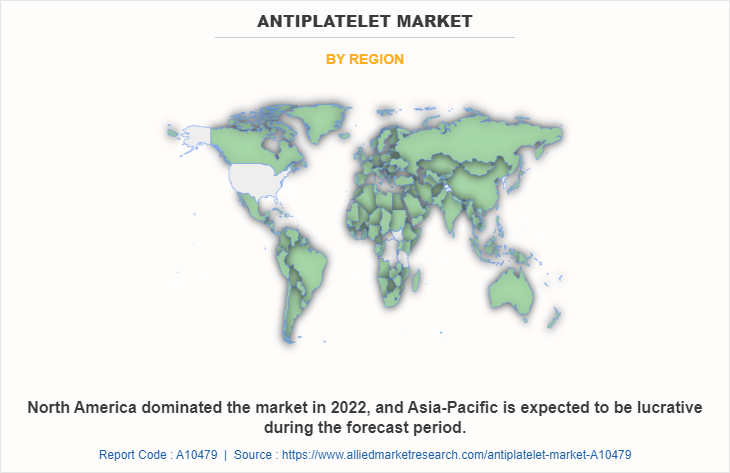
Moreover, rise in cases of cardiovascular diseases such as heart attack and stroke drive the demand for antiplatelet drugs that propels the market growth. For instance, according to the Centers for Disease Control and Prevention (CDC), every year, more than 795,000 people in the U.S. had a stroke and about 87% of all strokes are ischemic strokes, in which blood flow to the brain is blocked. Thus, rise in cases of cardiovascular diseases drives the market growth in this region.
Asia-Pacific is expected to grow at the highest rate during the forecast period. The antiplatelet market growth in this region is attributable to presence of pharmaceutical companies in the region as well as growth in the purchasing power of populated countries, such as China and India.
Asia-Pacific offers profitable opportunities for key players operating in the antiplatelet market, thereby registering the fastest growth rate during the forecast period, owing to the growth in infrastructure of industries, rise in spending for cardiovascular disease research, as well as well-established presence of domestic companies in the region. In addition, the rise in contract manufacturing organizations within the region provides great antiplatelet market opportunity for new entrants in this region.
Competition Analysis
Competitive analysis and profiles of the major players in the antiplatelet market, such as AstraZeneca plc, Bayer AG, Eli Lilly and Company, Glenmark Pharmaceuticals Limited, Cipla Ltd., Otsuka Pharmaceutical Co., Ltd., Lupin, Sanofi S.A. Sun Pharmaceutical Industries Limited, Daiichi Sankyo Company Limited, and Chiesi Farmaceutici S.p.A are provided in this report. Major players have adopted product approval as key developmental strategy to improve the product portfolio of the antiplatelet market.
Recent Product Approval in the Antiplatelet Market
In November 2020, AstraZeneca received the product approval for Brilinta (ticagrelor) in the U.S. to reduce the risk of stroke in patients with acute ischemic stroke or high-risk transient ischemic attack (TIA).
Key Benefits For Stakeholders
- This report provides a quantitative analysis of the market segments, current trends, estimations, and dynamics of the antiplatelet market analysis from 2022 to 2032 to identify the prevailing antiplatelet market opportunities.
- The market research is offered along with information related to key drivers, restraints, and opportunities.
- Porter's five forces analysis highlights the potency of buyers and suppliers to enable stakeholders make profit-oriented business decisions and strengthen their supplier-buyer network.
- In-depth analysis of the antiplatelet market segmentation assists to determine the prevailing market opportunities.
- Major countries in each region are mapped according to their revenue contribution to the global antiplatelet industry.
- Market player positioning facilitates benchmarking and provides a clear understanding of the present position of the market players.
- The report includes the analysis of the regional as well as global antiplatelet market trends, key players, market segments, application areas, and market growth strategies.
Antiplatelet Market Report Highlights
| Aspects | Details |
| Market Size By 2032 | USD 5.8 billion |
| Growth Rate | CAGR of 4.2% |
| Forecast period | 2022 - 2032 |
| Report Pages | 259 |
| By Drug Class |
|
| By Route of Administration |
|
| By Distribution Channel |
|
| By Region |
|
| Key Market Players | Otsuka Pharmaceutical Co., Ltd., Sanofi S.A., Cipla Ltd., Daiichi Sankyo Company Limited, Glenmark Pharmaceuticals Limited, AstraZeneca plc, Lupin, Bayer AG, Eli Lilly and Company., Chiesi Farmaceutici S.p.A. |
Analyst Review
This section provides various opinions of top-level CXOs in the antiplatelet market. According to the insights of CXOs, increase in demand for antiplatelet drugs to treat the cardiovascular diseases and rise in awareness about importance of early diagnosis and treatment are expected to offer profitable opportunities for the expansion of the market. In addition, patients are typically advised to take oral antiplatelet medications on a regular basis, as part of their ongoing treatment regimen. Thus, the need for continuous use of these medications drives the demand for the antiplatelet market growth. However, side effects of antiplatelets, such as shortness of breath and aspirin-induced asthma, hinder the market growth.?
CXOs further added that the surge in incidences of cardiovascular diseases such as heart attack and coronary heart disease drives the demand for antiplatelet drugs and support the market growth. Moreover, an increase in the aging population which has a high risk of developing cardiovascular diseases is one of the factors expected to further boost market growth.?
Furthermore, North America is expected to witness largest growth, in terms of revenue, owing to the increase in prevalence of cardiovascular diseases along with rise in geriatric population and presence of major key players in the region. However, Asia-Pacific is anticipated to witness notable growth, owing to rise in healthcare awareness and growing geriatric population that are suffering from cardiovascular diseases.
Oral is the leading route of administration of Antiplatelet Market.
North America is the largest regional market for Antiplatelet.
Factors such as the increase in the prevalence of cardiovascular diseases, such as heart attacks and stroke drive the demand for antiplatelet drugs.
The global antiplatelet market was valued at $3.8 billion in 2022, and is projected to reach $5.8 billion by 2032, growing at a CAGR of 4.2% from 2023 to 2032.
Major key players that operate in the antiplatelet market are AstraZeneca plc, Bayer AG, Eli Lilly and Company, Glenmark Pharmaceuticals Limited, Cipla Ltd., Otsuka Pharmaceutical Co., Ltd., Lupin, Sanofi S.A., Daiichi Sankyo Company Limited, and Chiesi Farmaceutici S.p.A.
2022 is the base year of Antiplatelet Market.
2023 to 2032 is the year forecast of the Antiplatelet Market.
Loading Table Of Content...
Loading Research Methodology...


